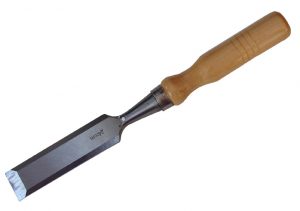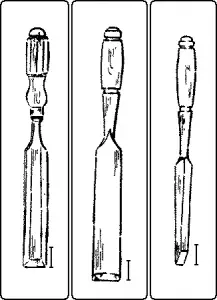If you take care of your tools, then your tools will take care of you.
And taking proper care of your chisel set is especially important, as regular use can blunt and deteriorate these useful instruments.
So, if you want to make sure that your chisels last a lifetime of where and tear, you’ve come to the right place. Why? Because this article answers the top most frequently asked questions about chisel maintenance.
Plus, we’ve also included a list of the best practices when it comes to caring for your chisels. So keep on reading to discover more…

This post may contain affiliate links to products that we receive a commission for (at no additional cost to you). Learn more here.
Q1: What are chiseling tools used for anyway?
Chisels are hand tools used to cut, carve, or chip away at materials such as wood, metal, or stone.
They are a popular tool for wood carving, and are composed of a sharp-shaped metal end with a wood or metal handle.
Woodworking chisels, specifically, are typically paired with wooden mallets (which are used to strike the handle of the chisel).
Q2: How would you dress a chisel?
Over time, as you repeatedly hammer away at the butt end of a chisel, you will notice that – namely with metal handle chisels – the end will begin to spread out into a sort of burgeoning ‘mushroom’ shape.
Why are mushroomed chisel heads dangerous?
Far from simply being a benign consequence of regular use, these blunted ends can be quite dangerous and a real safety issue.
If you were to continue to hammer away at a chisel with a mushroomed handle, a piece of the metal handle can chip off and go flying across the room, or into an eye.
So, to keep ourselves safe, we need to maintain the chisel by ‘dressing’ it.
Dressing a chisels handle is pretty straight forward. You will need to smooth down the mushroom shape by using a metal bevel to grind off the edges.
For a full tutorial on blunting down chisel butt ends, check out the guide below;
Now, when it comes to woodworking, typically your chisel will have a wooden handle. So having to dress the handle isn’t much of a factor.
But this doesn’t mean that you don’t need to worry about chisel related injury’s, as is further explained in the next question…
Q3: Why is a blunt chisel dangerous?
Keeping a chisel sharp is more than about tool upkeep. It is also a good safety tip.
You see, a blunt chisel requires more force to make the cut. And when you apply extra force – more often than not – this leads to slippage and awful hand injury’s. Which is why it is so important to keep your chisel sharp.
Q4: How do you sharpen a chisel?
There are three main ways you can go about sharpening the bevel tip;
Sandpaper
Sandpaper is a user friendly and cost effective way to sharpen your chisel.
Learn how by checking out Danny Lipford’s step-by-step guide below:
Waterstones
You can sharpen a chisel by holding it flat and scraping it lengthwise along a piece of waterstone.
The cost of a set of waterstones, (otherwise known as a whetstones), can range from as little as $50 to as much as $300 (for a top quality professional set).
Check out the latest prices for a range of affordable whetstones over on Amazon.
Or you can check out the Woodworkers Shop Youtube Channel tutorial below to learn more about how to apply this sharpening method:
Belt Grinder
If you have a need for speed, (when it comes to sharpening), then using a belt grinder will make quick work of it.
The tutorial by ‘Wood That I Could’ below will show you how;
Q5: Which chisel should never be used with a mallet?
The answer to this question is… Paring Chisels. Paring chisels should never be struck with a mallet of any kind. Let me explain…

These long slender bevel tipped chisels are used to make the most fine cuts.
Used for shaving off slivers of wood off a piece, these chisels should not be struck with a mallet due to their ‘Tang’ handles.
A Tang Handle is when the metal part of the chisel also makes up part of the handle.
For example, a full tang handle is when the chisel metal extends all the way through the full length of the wooden handle.
A partial tang handle, (this type of tang handle is more commonly used on Paring chisels), is when the metal extends through only part of the handle.
So, instead of striking these delicate chisels with a mallet, we simply push down on them by hand when applying force.
Conclusion
At the end of the day, keeping your chisels in tip-top condition is pretty straightforward.
And if you make a habit out of sticking to the 3 regular practices and checks listed below, you can be sure that every chisel in your set will always be ready to go whenever you are.
How To Take Care Of A Chisel (A Quick Summary)
- Check if your chisel is sharp enough.
If a chisel starts to show wear and tear in the form of dents or chips along its metal tip, it is time to replace it with a new one.
- Never use a mallet on a Paring Chisel.
Use your hand to force the chisel into the wood.
- Always inspect the butt end of metal-handle chisels BEFORE use.
And keep any mushroom-shaped handle ends in check.
